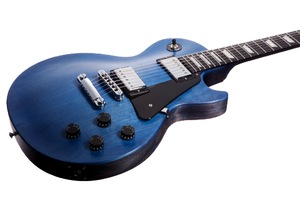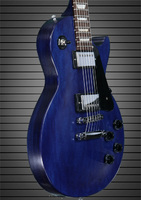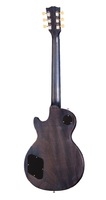A soft launch last Christmas, the Les Paul Blue with roasted maple fingerboard caught our attention. Get your pick and come meet the beauty.
FBI, Gibson’s official partner?
When special agent Jack Malone arrived at Gibby, we thought it would be for an endorsement contract. But we were wrong. John M. Rayfield (his real identity) was followed by several more agents, who were heavily armed to fight against wood smuggling. In order to cover the event, American media was invited and they broadcast this private showcase to the world. Screeching tires, counter-terrorist arsenal (in case of counterattacks from Nashville’s luthiers), war cries — just like a Hollywood action movie trailer. In spite of a legal loophole to substantiate the claim and ask for the wood purchase and export documents in question, the officer in charge of the investigation, Rayfiled, seized part of the rosewood and ebony in stock, some guitars and computer data.
Roasted? Like coffee?
To make up for the lack of rosewood and ebony, the manufacturer had to improvise in a very unorthodox manner because the only wood at their disposal was maple. Imagine a Les Paul Custom with a maple fingerboard… it’s out of the question! To give the guitars a real Gibson feel rather than a California touch, they decided to roast the fingerboard (yes, in an oven). This made it look like rosewood, but with a dryer feel to it. Skeptical but open-minded, it’s time for me to open the cardboard box and give this new affordable US beauty a try.
Getting Started
After opening the cardboard box, you’ll discover that the guitar is sold with a classy gigbag with the Gibson USA label on it. Some sort of black quiver with an immaculate white zip. Inside the bag a white and very soft protection foam will fend the guitar against the aggressions of everyday life. First surprise, thanks to a new chambered body, the guitar weights almost the same as an SG (the visits to the physiotherapist won’t be that often, I guess). As for wood, the chambered body and the neck are made out of mahogany with a maple top and the already described roasted maple fingerboard. Everything within typical dimensions: 628.6-mm scale length, 42.8-mm nut width, 22 frets and a '59-type shape. As for electronics, you get two Burstbuckers Pro pickups, a three-way toggle switch, two volume and two tone controls. The beauty wears a translucent blue dress showing the grains of the wood and the maple top. The faded finish gives the guitar an aged look — you’ll either like it or not at all!
First Step: Unplugged
The guitar sounds, it resonates and it’s wonderful! It’s always important to check if a guitar sounds good unplugged because all perfections and imperfections can be audible when the guitar is electrified. The chambered body generates a wonderful resonance (considering it’s an electric guitar) and a long sustain. The mid frequency range is pretty emphasized, certainly due to the maple top and fingerboard. For my side, I had a lot of fun playing this guitar for hours. The handling is easy, the '59-like neck feels very pleasant. Since I’m not used to varnish-free necks, I had some concerns about the playing comfort, but my doubts disappeared as soon as I experienced its smooth and slick feel under my fingers. The string action is rather low unlike with some factory settings. I know some of you are getting impatient, so it’s time to plug our guitar and check out the sound of the beauty.
Show Time!
|
Now, it’s time to warm up the tubes. I power on my small JTM 45 (yes, my neighbors don’t like me at all) feeding a small Vox cabinet equipped with Celestion Greenback speakers. During warm up, I add a strap to the guitar in order to try it out in stage-like conditions. Playing standing up I noticed that the weight doesn’t really match the Les Pauls I have played before. This guitar is light enough to allow you to jump on stage like a wild animal. The weight is somewhere between an SG and an LP Standard. I’m no muscleman like the Slayer metalheads, but I could surely withstand a full show without wrecking my back. The amp is hot and ready to scream.
Let’s start with low gain. I didn’t touch the EQ settings for any of the samples. The Burstbucker pickups reproduce every nuance of your playing, adding a slightly vintage touch. The neck pickup has a slight lack of warmth because it doesn’t produce too many low frequencies, which is rare on a Les Paul. On the contrary, the bridge pickup faithfully reproduces the brightness and the twang of the mid frequencies I heard when playing the guitar unplugged. Considering the output level of the “BBs”, I set the gain to max. You get an authentic rock/hard rock sound from the 80's. I was surprised to find myself playing Asia songs — don’t laugh.
In distortion mode, the neck pickup is still bright, but not fat enough for blues. The bridge pickup is biting, but a bit too aggressive for my taste. With my single-channel amp fully cranked up, the most pleasant situation was when the neck pickup volume control was almost set to minimum while the other pickup was set to max. That way I had a clean/crunch sound for verses and a distortion sound for solos and choruses. The pickup set is consistent with regard to the wooden parts of the guitar and keeps a coherent vintage spirit.
Conclusion
Once again, Gibson adds a new Les Paul Studio to their product catalog, but this time for under $800. Sold with a Deluxe gigbag, this young beauty will fulfill the expectations of vintage-sound fans who want a real US-made guitar. The sound variations emphasize the mid-frequency range because of the chambered body and the maple fingerboard. This will certainly not meet everybody’s taste. Moreover, I asked several luthiers about the roasted fingerboard and none of them could tell me how the wood would age and if the fingerboard would withstand a future refretting. Glossy finish fans won’t be too excited about the “old-school” finish. I had the opportunity to see two different guitars of this same model and I noticed inconsistencies in the finish quality. Thus, I recommend you to choose your guitar in a brick and mortar store.




